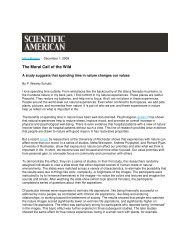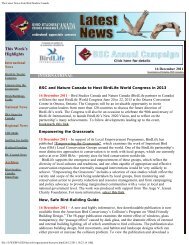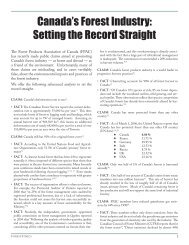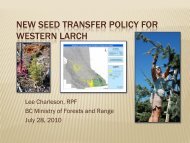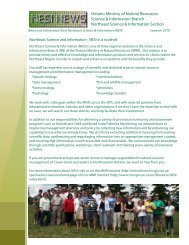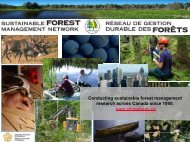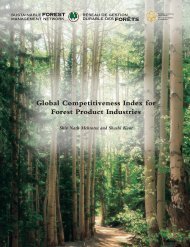a unique perspective a vision for canada's forests - Canadian ...
a unique perspective a vision for canada's forests - Canadian ...
a unique perspective a vision for canada's forests - Canadian ...
- No tags were found...
Create successful ePaper yourself
Turn your PDF publications into a flip-book with our unique Google optimized e-Paper software.
of the world’s largest producers of <strong>for</strong>est biofuels and bioenergy. Billions of dollars havebeen spent in Canada to foster bioenergy in general, and tens of millions have recentlybeen committed by governments to develop bioenergy networks to foster establishmentof conversion plants (e.g., BC Bioenergy Network). However, the less-newsworthy taskof ensuring sustainability of the <strong>for</strong>est resource while extracting more biomass has notreceived as much attention from government funding agencies and networks, even thoughthis is needed to underpin a sustainable bioenergy sector.It is there<strong>for</strong>e imperative that emerging <strong>for</strong>est bioenergy guidelines, regulations, policiesand legislation covering increased removals of <strong>for</strong>est biomass be built on a solidknowledge of environmental sustainability, be relevant within the context of current andanticipated <strong>for</strong>est operations in different jurisdictions across Canada, and be consistent inprinciple within a global context. Amongst other needs, this requires (i) reviewing andsynthesizing the national and international scientific literature, (ii) collating and theninterpreting current and relevant scientific data from <strong>Canadian</strong> <strong>for</strong>est ecosystems, (iii)reviewing current and anticipated trends in <strong>for</strong>est harvesting methods that will affectdistributions and removals of slash from sites, and (iv) reviewing current practices andpolicies in jurisdictions from around the world with more mature <strong>for</strong>est bioenergy sectorsso that key lessons learned can be applied in Canada. Once completed, policymakers inthe different jurisdictions across Canada can tailor this range of knowledge to their own<strong>unique</strong> ecological and jurisdictional circumstances, which can vary between provinces.Rather than repeating these universal kinds of tasks within each province, overallsavings could be achieved by coordinating ef<strong>for</strong>ts, creating synergies, and sharingoutputs amongst provinces.Tasks could be as simple as sharing costs <strong>for</strong> translating key documents only available in<strong>for</strong>eign languages (especially from Nordic countries), or creating annotatedbibliographies or relevant databases of <strong>for</strong>est nutrients or biodiversity; more complextasks could include definitive reviews and syntheses, meta-analyses of relevant scientificfindings, or developing protocols that could be applied across provinces <strong>for</strong> field trials,monitoring, or sampling as part of other routine <strong>for</strong>est management practices (e.g., remeasurementof <strong>for</strong>est inventory plots); a common website could also be used to sharein<strong>for</strong>mation generated.A workshop on sustainability was held in Toronto in Feb. 2008, and attended by ~130experts, largely from across Canada. One of the workshop conclusions was that Canadaneeds a <strong>for</strong>mal network to enhance sustainability RD&D <strong>for</strong> <strong>for</strong>est bioenergy. TheCIF/IFC supports this conclusion, and recommends that the CCFM facilitate attainmentof common objectives by pooling funds and establishing a network to accomplishfoundational tasks that are common to the provincial and federal governments. Webelieve that creating a network would increase synergy and reduce overall costs toindividual governments; we also believe that it would ensure more rapid uptake of thelatest knowledge by different governments and industry. This kind of network could becreated directly by the CCFM or, alternatively, the CCFM could provide funds andguiding principles so that cooperative work could be organized and administered byexisting national <strong>for</strong>estry agencies such as the SFMN, or the CIF/IFC.- 92 -



